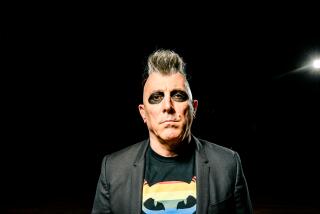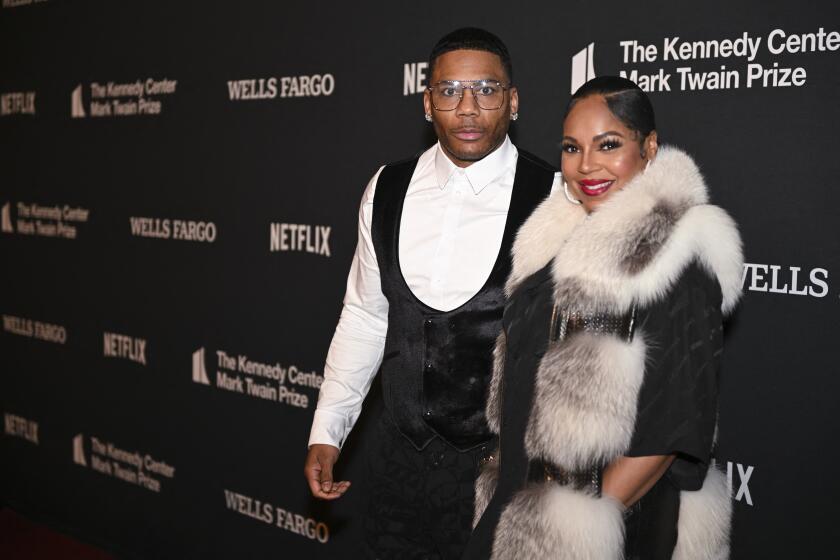A Cinderella story for Disney Music Group
For more than a decade, Walt Disney Co.’s Hollywood Records was an industry joke.
Now, it and Disney’s other labels are having the last laugh at a time when the rest of the beleaguered music industry has little to smile about.
Last week, 14-year-old Miley Cyrus bested “American Idol” star Kelly Clarkson with “Hannah Montana 2/Meet Miley Cyrus,” which debuted at the top of the Billboard 200.
That album’s success makes for something of a trifecta for Disney Music Group. Last year, Disney’s Nashville label had the nation’s top-selling artist in the superstar country band Rascal Flatts. It also scored the top-selling CD with the soundtrack for the Disney Channel’s “High School Musical” phenomenon, which sold 3.7 million copies.
“The Disney Music Group and Hollywood Records are sort of comeback kids at a moment where everyone else is having a tough time holding their position, much less gaining ground,” said Eric Garland, chief executive of BigChampagne, an online media measurement firm.
Elsewhere in the embattled music business, global CD sales have fallen for seven straight years. Digital technology has made copying music, as well as pirating it, a simple task, and the advent of Apple Inc.’s iTunes means people can easily download their favorite songs without buying an entire album.
Disney Music’s strategy has been to court an audience that its larger rivals have mostly ignored -- children and preteens, whose parents still buy CDs. It’s also leveraged the potent partnership it enjoys with the Disney Channel, a veritable launching pad for “tween” stars.
The two-disc “Hannah Montana 2/Meet Miley Cyrus” collection epitomizes the approach. Cyrus is the daughter of country singer Billy Ray Cyrus, who launched a thousand line dances with his hit “Achy Breaky Heart” in 1992. Now, thanks to the popularity of the Disney Channel’s “Hannah Montana” series, Miley is a big star on her own, especially among young girls.
Her album sold 326,000 CDs in the first week, ahead of Clarkson’s third studio effort, “My December,” with 291,000 copies sold. The first “Hannah Montana” soundtrack, which hit stores in October 2006, also debuted atop the Billboard album charts and was the eighth-biggest album of the year.
Much of the credit for Disney’s success goes to Music Group Chairman Bob Cavallo, an industry veteran who helped develop and manage such artists as Little Feat, Earth Wind & Fire and Prince. His Third Rail management company represented Seal, Green Day, Weezer and Alanis Morissette.
Cavallo was hired in 1998, taking a job few wanted. He oversees all of the company’s recorded music and music publishing operations, including Hollywood Records, Walt Disney Records, Lyric Street Records, Mammoth Records and Walt Disney Music Publishing.
Outside of the hit soundtrack for 1994’s “The Lion King,” success in the record business was scarce for Disney. Its roster -- with the exception of lucrative distribution rights for the 1970s group Queen -- was thin. It had passed on such future stars as Nirvana, Smashing Pumpkins and Dr. Dre.
“Hollywood Records was worse than a start-up record company,” Cavallo said. “It was the most maligned record company in recording history.”
Then-Disney Chief Executive Michael Eisner made Cavallo a simple pitch: It can’t get any worse. “You can’t fall off the floor,” Cavallo recalled Eisner telling him. “You’ll have to succeed to some degree.”
It took a while for things to improve. In 2002, Cavallo said, Disney directors considered pulling the plug on the operation but relented at the urging of current CEO Bob Iger.
“We hadn’t made money,” Cavallo said. “Now, we’ve pretty much doubled our profits every year since. We’re like a major.”
The starting point for that turnaround came in the form of Disney Channel star Hilary Duff.
After her first season starring in the hit show “Lizzie McGuire,” Duff approached Gary Marsh, president of entertainment for Disney Channel Worldwide, saying she really wanted to sing. Within 24 hours, he introduced Duff to Cavallo.
That led to the release of the “Lizzie McGuire TV Soundtrack,” the “Lizzie McGuire Movie” soundtrack and five albums Duff released as a solo performer. Since August 2002, the CDs have sold more than 10.8 million copies, according to Nielsen SoundScan.
“That put us on the map,” Cavallo said. “It also began to teach us how to use the Disney Channel, which is fantastic at building brands.”
Duff was the first artist for which the Disney Channel served as a creative incubator and a promotional slingshot. It developed a knack for propelling sales of budding artists who struggled to be heard beyond Radio Disney. It was a Disney cycle in which television, radio and, occasionally, the film studio reinforced one another with an almost inescapable buzz.
“It’s our ability to leverage the synergy of the Walt Disney Co. worldwide that has made us the envy and the scourge of the music industry,” Marsh said. “We are the envy because of our success and the scourge because no other company has the resources and the collaborative spirit that we do to duplicate our strategy.”
Other hits followed. After modest success with the female group SheDaisy, Disney’s country label, Lyric Street Records, came alive, thanks to Rascal Flatts. The Hollywood Records rock group Breaking Benjamin released an album that went platinum. Other artists followed such as Jesse McCartney, the Cheetah Girls and Aly & AJ.
Cavallo and his artists and repertoire staff’s finely tuned ears -- and its well-honed promotional chops -- enable it to pursue and sign emerging acts such as Grace Potter and the Nocturnals, who fall outside the Disney Channel’s core audience. One of these bands, Plain White T’s, has the top digital track on Billboard this week, “Hey There Delilah.”
“Bob has been totally the architect of the whole Disney Music Group’s success in the last few years,” said Dick Cook, chairman of Walt Disney Studios. “He saw where the business might go and could go and has been able to take from this huge success at the Disney Channel, to capitalize on the tremendous talent of the performers.”
Garland said labels have long coveted record buyers from 12 to 24 years of age, a market whose tastes are increasingly hard to pin down.
“But if you market to people over 24 or their very small children, it’s the same pocketbook you’re picking,” Garland said. “It’s almost like Disney is benefiting from the shifting marketplace.”
Cavallo revels in a strategy that makes Disney Music a bit of an anachronism.
“The great record executives I’ve known through the years ... they’re looking for the next Bruce Springsteen or Fall Out Boy or some new alternative band that’s ironic,” Cavallo said. “I’ve got these little kids singing female empowerment songs.”
--
(BEGIN TEXT OF INFOBOX)
Spinning sales
Market share of Disney Music Group and the other labels, 2006
Universal: 31.6%
Sony/BMG: 27.4%
Warner: 18.1%
EMI: 10.2%
Others: 9.3%
Disney: 3.3%
--
Source: Nielsen SoundScan
--
Los Angeles Times
More to Read
The biggest entertainment stories
Get our big stories about Hollywood, film, television, music, arts, culture and more right in your inbox as soon as they publish.
You may occasionally receive promotional content from the Los Angeles Times.






